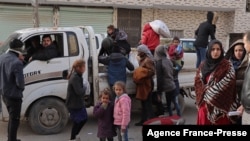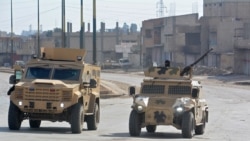Residents of Hasakah in northeastern Syria endured a fifth night of gunfire and explosions as fighting between the U.S.-backed Syrian Democratic Forces and fighters with the Islamic State terror group there raged into a sixth day.
Video from activists on the ground near the al-Sina’a prison and shared with VOA showed repeated flashes and explosions while the constant drumbeat of gunfire could be heard echoing in the background.
VOA could not independently confirm the authenticity of the video, but other accounts on social media from activists and residents, including the British-based Syrian Observatory for Human Rights, said fighting continued unabated as SDF troops tried to retake control of the entire prison and root out IS fighters still holed up in surrounding neighborhoods.
Multiple U.S. officials Monday told to VOA that the U.S. and coalition increased their support the SDF to help retake the prison and were now sending in armored vehicles “strategically positioned to assist with security” in addition to providing real-time aerial intelligence and precision airstrikes.
“There's been some limited ground support," Pentagon press secretary John Kirby said later, during a briefing, in response to a question from VOA. “For instance, putting Bradley fighting vehicles across access points to help block as obstacles.”
SDF officials, meanwhile, said about 300 IS fighters and prisoners surrendered early Monday after SDF forces stormed one of the buildings in the prison.
An SDF spokesperson also urged holdouts to give up, sharing a “final call for safe surrender” on social media.
“We know that you have internet connection and see your setbacks,” an English version of the warning said. “You are completely surrounded by our forces and there is no way out.”
“Surrender yourselves. Do not chose the final dance of death,” it added.
In all, SDF officials have said about 10,000 troops have been brought in to quell the prison break, which began late Thursday when IS sleeper cells converged on the prison and detonated at least one car bomb.
So far, the SDF officials have said more than 180 IS fighters and prisoners have been killed, while at least 28 of their own troops have been killed.
The SDF said at least five civilians are also dead, saying at least one was beheaded by IS fighters for refusing to allow them into a residence.
While the fighting rages, United Nations officials and humanitarian groups have raised concerns about Hasakah’s residents.
U.N. officials estimate that at least 45,000 people have been displaced by the fighting while the International Committee of the Red Cross called on all parties to allow "unhindered humanitarian access" to areas around the prison.
“With temperatures dropping below freezing in northeast Syria, we are deeply concerned about the situation of people forced to flee their homes who need access to shelter, food, water, health services and above all a safe environment,” the head of the ICRC’s Syrian delegation, Christophe Martin, said in a statement.
U.N. and humanitarian officials have also voiced concern about some 850 children, mostly boys and teenagers, kept in nearby detention facilities, especially following reports by the SDF that IS fighters had been using them as human shields.
At the same time, communities across northeastern Syria, especially those near other prisons, are preparing for the possibility of more attacks.
According to the Rojava Information Center, a pro-Kurdish research group, regional officials have imposed curfews on multiple cities across northeastern Syria, while there have been reports of additional IS attacks on several SDF positions in and around Deir el-Zor.
“Definitely, we anticipate further attacks on prisons and camps,” a Western counterterrorism official told VOA on the condition of anonymity in order to discuss sensitive information.
“This has been a major theme of all recent ISIS leadership communications,” the official added, saying the attack on the al-Sina’a prison in Hasakah was “not surprising.”
Separately, a U.S. official, also speaking on the condition of anonymity, told VOA the attempted prison break is “certainly a troubling event” and described the size of the attacking force as “significant.”
The official further warned that the ability for IS to communicate and coordinate with prisoners inside the al-Sina’a prison was equally alarming.
Both officials expressed doubt that the ongoing attack on al-Sina’a would ultimately be successful, but IS has sought to seize on what it has called "a broad offensive," using its Amaq news agency and social media channels to pump out a steady stream of propaganda.
One video, posted Sunday, claimed to show scenes from inside the prison, including what IS said were captured and dead SDF personnel.
VOA was not able to independently confirm the authenticity of the video, but according to a translation by SITE Intelligence Group, an IS fighter vowed to fight to the death.
“We will not withdraw until Allah grants us conquest,” he said. “Or we die.”
Separately, a series of social media posts seen and translated by SITE has shown IS supporters from across the world, including children, holding handwritten notes of support for the operation.
“This will be a boon for ISIS and so they'll consider this a success no matter what,” Colin Clarke, director of policy and research at the global intelligence firm The Soufan Group, told VOA.
But it is the big-picture coordination of the attack on the al-Sina’a prison, on the ground, especially, and on social media, that he finds most worrisome.
“This was clearly part of a more deliberate campaign aimed at generating momentum,” he said. “This could very well be the beginning of a sustained campaign to make noise, to generate propaganda which will help with recruitment.”
Clarke and other analysts also caution that the effort to launch a major prison break is reminiscent of the terror group’s early playbook, when IS strengthened its ranks with what became known as “Breaking the Walls” during which it repeatedly targeted prisons.
“The Breaking the Walls campaign gave ISIS a tremendous amount of strength and capacity,” Daveed Gartenstein-Ross, a counterterrorism analyst and the CEO of Valens Global, told VOA.
Whether a new series of attacks on prisons holding IS fighters can do the same, however, is no sure thing, especially given reports that in the case of the attack in Hasakah, most of the IS sleeper cell forces have been killed and that few prisoners have escaped.
“It's not really possible to calculate the fog of war,” Gartenstein-Ross said. “The full strategic impact may not be known for months or even years.”
Mutlu Civiroglu and Margaret Besheer contributed to this report.










